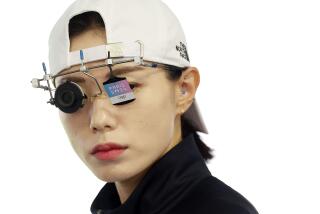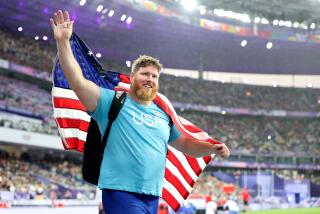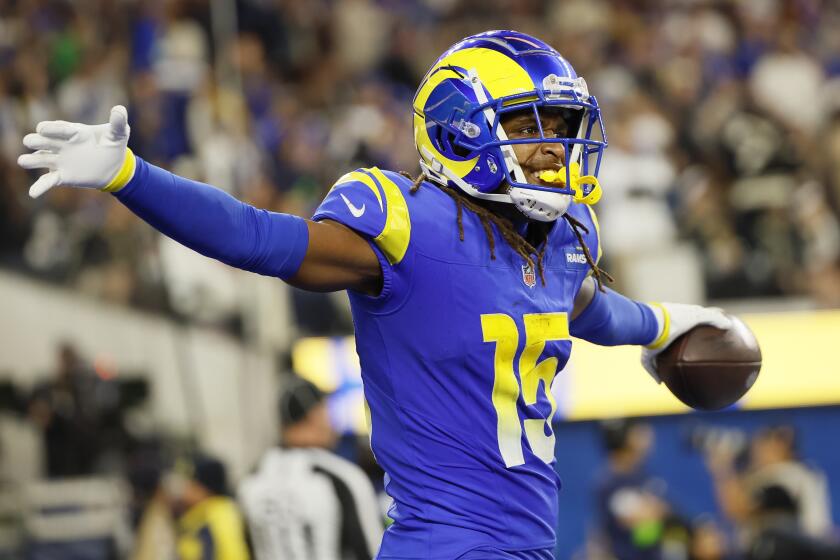In Search of a Better Free Throw
Many people say he was the greatest basketball player of all time. Wilt Chamberlain, the ultimate inside force, dominated professional basketball in the 1960s the way few players have before or since.
He was a four-time most valuable player and seven-time scoring leader. He is one of only two players to score more than 30,000 career points and the only player to average more than 30 points in a career.
But even during Chamberlain’s prime, if you placed him only 15 feet away from the basket with nobody guarding him and the action ground to a halt, he would toss up enough bricks to build a couple of houses and still have plenty left for a backyard barbecue grill.
The free throw, supposedly the easiest shot in basketball, has confounded even the greatest players over the years.
For every Larry Bird (lifetime free-throw percentage of nearly .880), there is a Chamberlain (51-percent career average, all-time low of 38 percent in 1967-68) providing evidence that the free throw actually is the biggest mental game of any sport.
What is it about such a simple shot that can turn some of the world’s best athletes into such helpless bricklayers? How can a national powerhouse such as Syracuse last year shoot only 61 percent.
Maybe it’s all in the wording.
“It starts with the name: free throw. The name itself suggests this is a shot that is so easy you can’t miss,” Birmingham-Southern Coach Duane Reboul said. “There’s initial pressure just by the title of the shot. That’s where it begins. Some people walk up to the line and say, ‘I’m supposed to make this shot,’ and start thinking about the result as opposed to just doing the fundamentals correctly. Once you start thinking about the shot, you’re in trouble.”
But what else is there to think about? In a game of almost constant motion, the action is stopped. All eyes in the arena are focused on the free-throw shooter, whose shots might be the difference.
How can you not think about the shot?
“It’s not easy,” said Alabama Birmingham forward Andy Kennedy, who sank 85 percent of his attempts last year. “But it’s all just a mind game. When I’m on the line and I catch myself thinking about the importance of a free throw, I just shut it out and think about practice. I start talking to myself--you can probably see my lips move--and I’m saying, ‘Just like in practice.’ Then I just go up there and knock them both in and don’t even think about the importance of it.
“Basketball is such an up-and-down game. It’s constant motion. And suddenly you get fouled and everything stops. It’s just you and the rim. It’s a big change in the flow of the game and a lot of people don’t handle it very well.”
“I shouldn’t have let it (the free throws) bother me so much. But I wanted to excel at everything. And the harder I tried, the more different ways I tried to shoot, the worse I got.”--Chamberlain in his 1973 autobiography “Wilt.”
One of the most difficult situations a basketball coach faces is deciding what to do with a poor free-throw shooter. Some coaches let the players work out their own problems; others push players during practice to work on technique.
“I’ve had several players over the years that I shuddered whenever they went to the free-throw line,” UAB Coach Gene Bartow said. “But I think you can take most anybody and if you work with them on their form and release and they practice it, then they’ll get better. But they have to be dedicated to getting better.
“Wilt Chamberlain was a horrible free-throw shooter. But I feel if I could have had him for 10 minutes a day, I eventually could have had him shooting 70 percent. But I couldn’t if he wouldn’t listen to me, and knowing Wilt like I know him, he probably wouldn’t have listened.”
There is no doubt that poor free-throw shooters can improve. During his first two seasons at Alabama, guard Bryant Lancaster made only seven of 31 free-throw attempts (22.6%).
“I couldn’t stand to go to the line,” Lancaster said. “That’s how bad my confidence was last year.”
But Lancaster worked long and hard on his shooting during the off-season, then received that all-important mental boost from Alabama Coach Wimp Sanderson when he named Lancaster a starter at the shooting guard position in preseason. He made 15 of his first 19 free throws.
Last season, South Florida center Hakim Shahid sank only 55% of his attempts. So during the off-season, he practiced on his own. There was no coach or adviser standing over his shoulder telling him what to do. He simply worked on the shot until it felt right.
The result? Shahid is making 83% of his free throws.
Keeping in mind the fragile mentality of free-throw shooters, USF coach Bobby Paschal has avoided talking to Shahid about his newfound accuracy.
“I just told him to spend a lot of time working on his free throws over the off-season, and apparently he did,” Paschal said. “When I saw during preseason practice that he was shooting the ball so well, I just shut up. I figure I’d better leave well enough alone.”
The silent treatment is a technique some coaches prefer in curing a player’s free-throw ills.
“When you start talking about it and spending too much time at practice saying how important free throws are,” Reboul said, “then every time a guy goes to the line he starts thinking about all that rather than the mechanics. I’ve never had a team shoot free throws poorly and I’ve always used this approach.”
--Historic moments in free-throw shooting, No. 2: June 25, 1977. Ted St. Martin sets up a basketball goal in a Jacksonville, Fla., shopping mall and begins shooting. He doesn’t stop until sinking 2,036 consecutive free throws, still the world record. The 5-7 St. Martin was 41 years old at the time. On Saturday, during halftime of the Duke-Wake Forest game, St. Martin, who is now 54, will attempt to break his record of 169 free-throw conversions in 10 minutes. That is 17 free throws per minute, or one every 3.5 seconds.
St. Martin believes free-throw shooting is one of the easiest plays in all of sports and any decent athlete should make the shot with regularity. No excuses.
“There’s no reason for anybody not to make the shot at least 75 percent of the time,” St. Martin said. “It’s such a simple shot.”
St. Martin said the technique and form needed to become a consistent free-throw shooter is so basic that anybody can learn it with a little practice. So he is convinced that players who have trouble sinking the shot either haven’t practiced enough or let their mind wander at the line.
“A lot of it is mental,” St. Martin said. “I used to be exactly like these other guys. I’d get a string going and start thinking, ‘It’s time to miss.’ You can’t have that in your mind.”
St. Martin lists seven basic steps for success:
1) Be comfortable. “If you’re tense, then your body is tense and your motion will be tight and unnatural.”
2) Have a soft grip on the ball. “I hold it like I’m holding an egg. This gives you a smooth delivery and follow-through.”
3) Use a high arc. “This is where much of the problem is for people. They shoot the ball too flat.”
4) Have a soft rotation. “Too much and the ball will roll out.”
5) Eliminate unnecessary body motion. “The more you eliminate movement, the less chance for error. Some guys get up there and bend over like they’re trying to tie their shoes. This is especially important in clutch situations, because you’re a little nervous.”
6) Keep your eye on the rim. “Don’t watch the ball.”
7) Don’t stand at the line too long. “You’re defeating yourself. You don’t want to be in a hurry, but if you stand there, you start thinking about the shot.”
St. Martin rattles off this list as if he has experience teaching a class. But actually, he said very few teams inquire about his services.
“I don’t get as many requests as I should,” he said. “It’s a shame. I can definitely help because the shot is so teachable.”
It has been established, then, that this shot, which frustrates so many talented athletes, actually is so easy it’s a joke. Then what’s the problem? How can so many be so bad doing something so basic?
South Florida’s Paschal has an interesting theory.
“So many guys who play basketball in college started playing when they were kids on playgrounds and in pickup games,” Paschal said. “Even once they get to college, during the offseason most of the guys just go to the gym and get in a pickup game.
“Now, one of the things guys don’t do much of in pickup games is shoot foul shots. That’s why we emphasize to our players that they shouldn’t just spend time during the off-season playing pickup games. We tell them they’ve got to work on their shooting as well.”
Paschal said he believes the lack of free-throw shooting on city playgrounds carries over to high school, where the shot seldom is emphasized. As a result, high school players don’t learn the basics of shooting free throws. By the time they get to college, Paschal said, they already have established bad habits that are hard to break.
--Historic moments in free-throw shooting, No. 3: March 12, 1971. Boston Celtic rookie Garfield Smith goes to the line in a three-for-two bonus situation (three attempts to make two shots, a rule that no longer exists). Smith, only a 39% free-throw shooter anyway, tosses up three consecutive airballs. One misses to the left, one to the right and one is considerably short. None of the three comes close to the rim. Smith is out of the NBA the following season.
In a game where the Garfield Smiths and the Chris Dudleys are immortalized because of their poor shooting, UAB’s Bartow said there is one important thing to remember: Good shooters will make their free throws regardless of the situation.
“I have never seen a great shooter, a guy who has great form and technique in his shooting, who wasn’t able to go to that free-throw line and shoot at least 75 and usually in the 80s,” he said. “It’s a very, very, very important part of the game that you try to have as good as you can. If you don’t, then you’re in trouble.”
More to Read
Go beyond the scoreboard
Get the latest on L.A.'s teams in the daily Sports Report newsletter.
You may occasionally receive promotional content from the Los Angeles Times.










